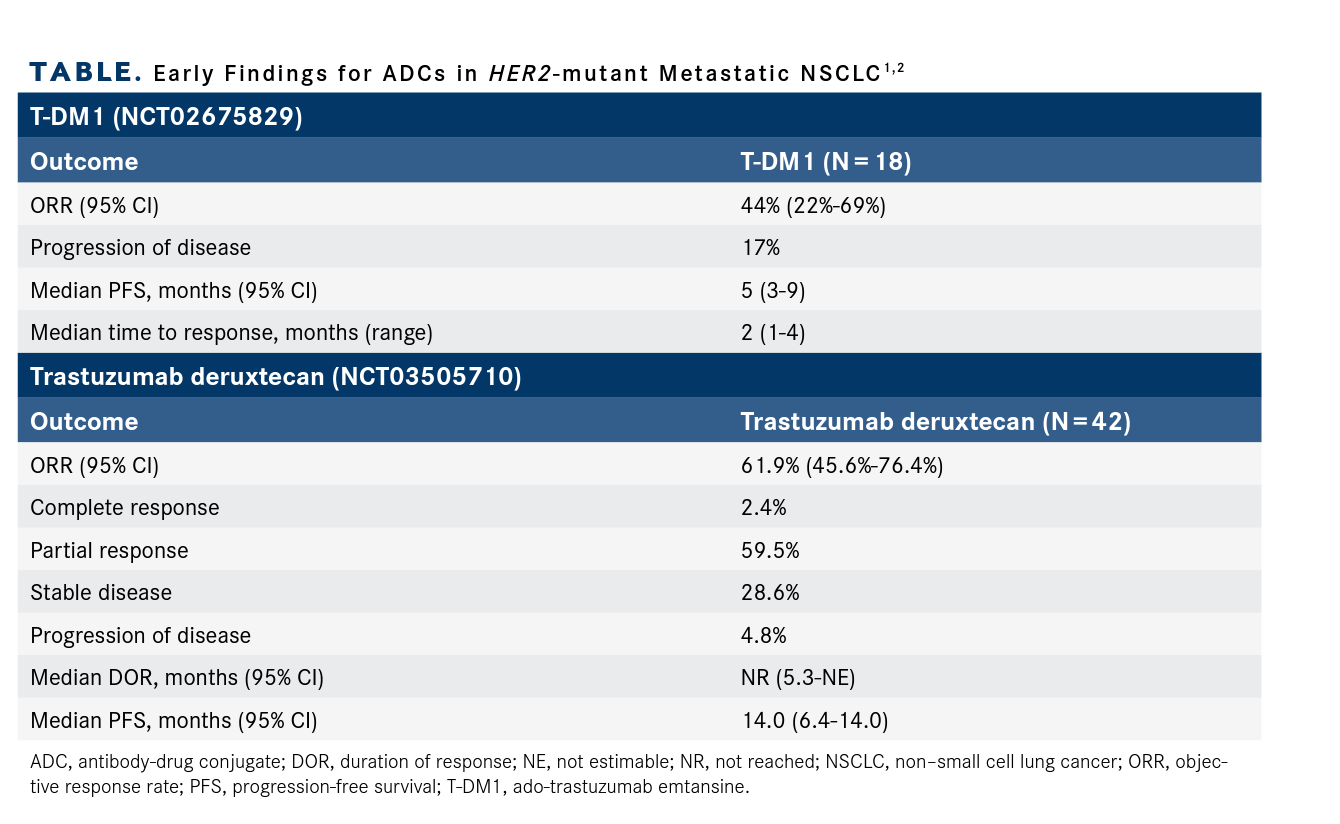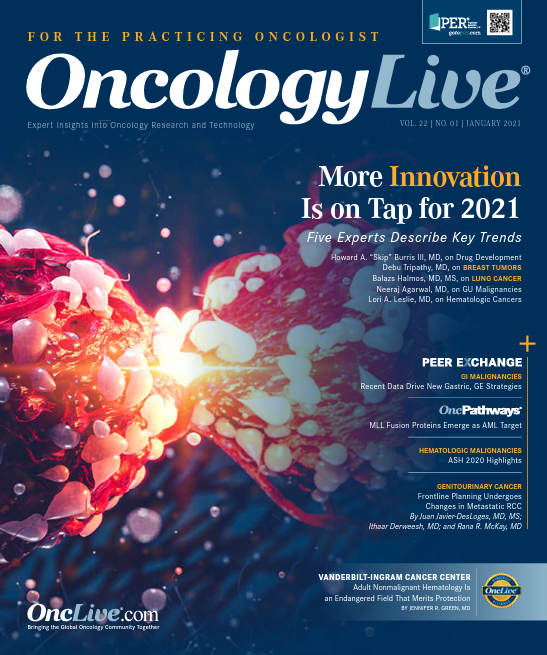HER2-Directed Antibody-Drug Conjugates May Carve Out a Place in NSCLC Landscape
The current standard of care for patients with non–small cell lung cancer does not include therapies targeting HER2, a mutation that occurs in up to 4% of cases. However, data from recent studies of antibody-drug conjugates directed at HER2 activity are generating excitement about the potential utility of ADCs in this space.
Hossein Borghaei, DO, MS

The current standard of care for patients with non–small cell lung cancer (NSCLC) does not include therapies targeting HER2, a mutation that occurs in up to 4% of cases. However, data from recent studies of antibody-drug conjugates (ADCs) directed at HER2 activity are generating excitement about the potential utility of ADCs in this space. Specifically, efficacy data from phase 2 trials have described HER2 gene mutations as an emerging biomarker to identify therapies for patients with metastatic disease (TABLE1,2).1-3
Ado-trastuzumab emtansine (T-DM1; Kadcyla) broke the historical trend of low response rates to HER2-directed therapies in lung cancer with data from a phase 2 basket trial (NCT02675829), which examined the ADC in a cohort of patients with advanced HER2-mutant lung adenocarcinoma. The objective response rate (ORR) among 18 patients with HER2 mutations was 44% (95% CI, 22%-69%), all partial and confirmed responses. The median progression-free survival (PFS) for all patients in the cohort was 5 months (95% CI, 3-9), whereas the median PFS for responders was 6 months (95% CI, 4–not reached).1
Data from DESTINY-Lung01 (NCT03505710), a phase 2 trial involving the ADC fam-trastuzumab deruxtecan-nxki (Enhertu), further solidified the potential role of these agents in patients with HER2-mutant disease. An interim analysis presented at the 2020 American Society of Clinical Oncology Virtual Scientific Program (2020 ASCO) showed an ORR of 61.9% (95% CI, 45.6%-76.4%) in 42 patients with unresectable/metastatic nonsquamous NSCLC treated with trastuzumab deruxtecan.2 Further, the median PFS was 14 months (95% CI, 6.4-14.0), and median overall survival was not reached (95% CI, 11.8–not reached).
“Antibody-drug conjugates are showing promising data in breast cancer, and some of that efficacy has been observed in data in lung cancer,” said Hossein Borghaei, DO, MS, during an OncLive® Lung Cancer Talk video program. Borghaei was joined by Balazs Halmos, MD, MS; Jarushka Naidoo, MBBCh; and Joshua M. Bauml, MD, in reviewing the latest data that pave a path forward for the role of HER2-targeted agents for patients with metastatic lung cancer.
The methods for establishing the most effective biomarker for HER2-targeted therapies were a key focus in the discussion. Whereas HER2 positivity has been defined by immunohistochemistry (IHC) protein expression (IHC 3+ or IHC 2+) for breast cancer therapy, emerging data in NSCLC are identifying responses in patients with HER2 activating mutations through molecular analysis of tissue samples.1,2 Borghaei estimated the rate of HER2 mutations in NSCLC at 2% to 4% and HER2 overexpression by IHC testing at up to 30%.
TABLE. Early Findings for ADCs in HER2-mutant Metastatic NSCLC1,2

Novel Compounds Leave an Impression
Borghaei: Trastuzumab deruxtecan seems to be garnering a lot of attention, primarily because it has received breakthrough therapy designation from the FDA in NSCLC, and it’s already approved in breast [and gastric] cancers.
At the 2020 ASCO meeting, data were presented from a phase 2 study that investigated the utility of the compound in patients with NSCLC and a HER2 mutation. Keep in mind this is not the IHC overexpression that we were talking about; this is strictly the HER2-mutated NSCLC. Patients who participated in this study had received prior chemotherapy, and the majority had received chemotherapy plus immunotherapy.
The patient population was very similar to that of other NSCLC studies that we’ve seen in this setting. Interestingly, based on a 42-patient data set, a response rate of nearly 62% was reported, which is pretty eye-catching. The median duration of response was not reached at the time of the initial presentation. It looks like a very active, very interesting compound.
There is a specific toxicity that I think we should discuss. With this compound you do have to worry about interstitial lung disease or pneumonitis because it can happen, and learning how to mitigate some of that is important to clearing the established safety of the compound and, of course, making sure that patients are identified if they have that.
The median PFS was around 14 months, which was pretty interesting for a patient population that’s already been treated. So it does appear that we’re making some progress. ADCs, at least with this particular compound, seem to be very promising, and subsequent studies are needed to establish their role.
Based on these efficacy data, do we move this agent to the front line? Or is this compound strictly for patients who’ve had chemoimmunotherapy? I think subsequent studies are going to [evaluate] the importance of establishing a role for these kinds of compounds.
Joshua Bauml, MD

Bauml: This is a very interesting situation because in contrast with RET inhibitors, for instance, these drugs—both T-DM1 and trastuzumab deruxtecan—are already approved by the FDA in other indications such as breast cancer; you can access them.
So if you have a patient who comes in with a HER2 exon 20 mutation, what are you doing now? If you have access to a clinical trial, I’m sure that’s what you’re selecting for your patient.
But if you don’t enroll on a trial and that patient comes to your door, Dr. Naidoo, what are you doing?
Jarushka Naidoo, MBBCh

Naidoo: I present both options [T-DM1 and trastuzumab deruxtecan] to the patient, and I print it out on paper and go through it with them. Now, usually their eyes glaze over a little bit, I have to admit, and at the end they might say, “What would you do if you were me?” But I feel better showing them what the 2 options are and saying I don’t clearly know which one may be better for you, but I will balance my decision, taking their comorbidities into account as well as various other things. I think that is the fairest way to approach it.
I have a lot more clinical experience with T-DM1. I’ve given it to patients with NSCLC with HER2 aberrations for several years, and in a past life, when I treated patients with breast cancer, I had certainly given T-DM1.
I think there is a certain level of clinical familiarity that providers are probably going to have that may sway them in the direction of T-DM1. However, when we have a very exciting agent with a very impressive response rate, and when the phase 2 data that supported the use of T-DM1 do not look as impressive as those for trastuzumab deruxtecan, I think that that may change over time.
Bauml: When you’re using T-DM1 or trastuzumab deruxtecan, are you using them after chemoimmunotherapy? Are you using them in the first line? How are you approaching that?
Naidoo: Again, it’s a similar approach to a RET inhibitor. I’m a believer that oncogenic drivers are driving the growth of the cancer. If a patient is stable and can wait for the results of testing, I would prefer to give it in the first line.
Bauml: Interesting. Dr Halmos, where are you using these agents right now?
Balazs Halmos, MD, MS

Halmos: I think we need to learn a little bit more in this setting. I don’t think I’m fully comfortable using them in the first line yet, especially, for example, in HER2-mutated disease because of the bad pneumonitis. There’s that risk—how is it going to play out?
It’s such a complex molecule, and as a result, there’s a lot of nuance. I think I would love to learn a little more about it before replacing a fairly effective treatment up front for most of our patients with metastatic lung cancer, and that is chemotherapy.
I would sequence them more in the secondline setting, but I am very eager to learn more about these compounds, including TKIs [tyrosine kinase inhibitors] that are moving along in the HER2 field, as well.
Borghaei: What I like about ADCs is that if we can establish that by detecting the HER2 overexpression using IHC, we can actually show clinical utility.
If an ADC works the way it’s promised— the antibody moiety binds to HER2, as long as it’s overexpressed—and is internalized and goes to the target, it could potentially have a lot more utility. Unless there are specific mutations that prevent internalization, or if the cancer cell is inherently resistant to the protection of chemotherapy that’s being used as a toxic payload, the clinical utility of the agent can be expanded a little.
I think these are important topics to explore in the future studies. In fact, the study that we’re running will test this particular compound [trastuzumab deruxtecan] in both patients with a HER2 mutation and those with HER2 overexpression. We should be able to generate some data in these settings to see where the clinical utility really lies [NCT04042701].4
Bauml: What’s fascinating about these agents is that these ADCs are gigantic molecules; they are huge. So it is not expected that they’re going to penetrate the CNS [central nervous system]; it is not expected they are going to be getting into the cells.
But what’s remarkable, in a paper about T-DM1, Li et al did an enormously elegant analysis where they looked at what factors lead to response.1 Investigators performed IHC, FISH [fluorescence in situ hybridization], mass spectroscopy, and mutation analysis, and the only thing associated with response was mutation, which shouldn’t be the case.
It should not make any sense given how these drugs work, and yet that is exactly what we see. I wonder with trastuzumab deruxtecan—which has a much higher response rate, a much longer durable response—whether we’re still going to see that same thing. But what I took away from the toxicity profile of trastuzumab deruxtecan is that it looks a lot like chemotherapy. Although it is a targeted agent, the adverse effect profile looks similar to that of a platinum doublet.
Borghaei: But that’s not unprecedented. We’ve seen other ADCs that have similar profiles because the toxic payload is basically cytotoxic as you get into it. Now, I’ve seen the data for patients with a HER2 mutation, and in terms of predicting responsiveness, I’m also a little puzzled to the extent that I’m trying to communicate with the investigators about how to best explain a drug that’s supposed to bind to a specific target.
Why is it that in a patient with a HER2 mutation, it actually does seem to be working better? I don’t think there is any clear evidence at this point, at least not an explanation that I have seen, that’s satisfactory. I’ve seen the same data, and yes, I do question them. It’s an ADC; the simple mechanism is supposed to be the antibody binds the target, it’s internalized, the toxin is released, and you get your activity. But unfortunately, the patients experience some adverse effects because the drug does get out into the systemic circulation.
Halmos: Let me mention that this highlights how much we don’t know about HER2 expression and HER2 amplification in lung cancer. It’s one thing for a subset of patients who have a mutation that is oncogenic, actionable, and important for the cancer to survive to have that identified pathway. But for those who have HER2 overexpression, resistance may emerge within weeks or as selection of subclones that don’t express it. So any long-term mutation to the compound is simply not realistic.
Naidoo: I think on that, as well, the mutation matters. Similarly, the paper you referenced, as well as other work, has shown that patients with exon 20 YVMA insertions appear to have poorer responses. So obviously having a familiarity with exactly what you’re treating is the first step.
Bauml: Maybe the HER2 mutation predicts the binding specificity, or it somehow affects weak or stronger binding, depending on the kind of mutation. Maybe it has something to do with that, and again, as was pointed out, we simply don’t understand much of it. Clinical development is a lot faster than the science.
Usually we have a little more science than clinical development, and here the drugs are working, we’re trying to use [them], but we don’t understand what exactly is going on from a science point of view.
References
- Li BT, Shen R, Buonocore D, et al. Ado-trastuzumab emtansine for patients with HER2-mutant lung cancers: results from a phase II basket trial. J Clin Oncol. 2018;36(24):2532-2537. Published correction appears in J Clin Oncol. 2019;37(4):362. doi:10.1200/ JCO.2018.77.9777
- Smit EF, Nakagawa K, Nagasaka M, et al. Trastuzumab deruxtecan (T-DXd; DS-8201) in patients with HER2-mutated metastatic non-small cell lung cancer (NSCLC): interim results of DESTINY-Lung01. J Clin Oncol. 2020;38(suppl 15):9504. doi:10.1200/ JCO.2020.38.15_suppl.9504
- NCCN. Clinical Practice Guidelines in Oncology. Non-small cell lung cancer, version 1.2021. Accessed December 4, 2020. https://www. nccn.org/professionals/physician_gls/pdf/nscl.pdf
- Borghaei H, Besse B, Bardia A, et al. Trastuzumab deruxtecan (T-DXd; DS-8201) in combination with pembrolizumab in patients with advanced/metastatic breast or non-small cell lung cancer (NSCLC): a phase Ib, multicenter, study. J Clin Oncol. 2020;38(suppl 15):TPS1100. doi:10.1200/JCO.2020.38.15_suppl.TPS1100




